Chia Seed vs. Flax Seed: Similarities, Differences, and When To Use Each
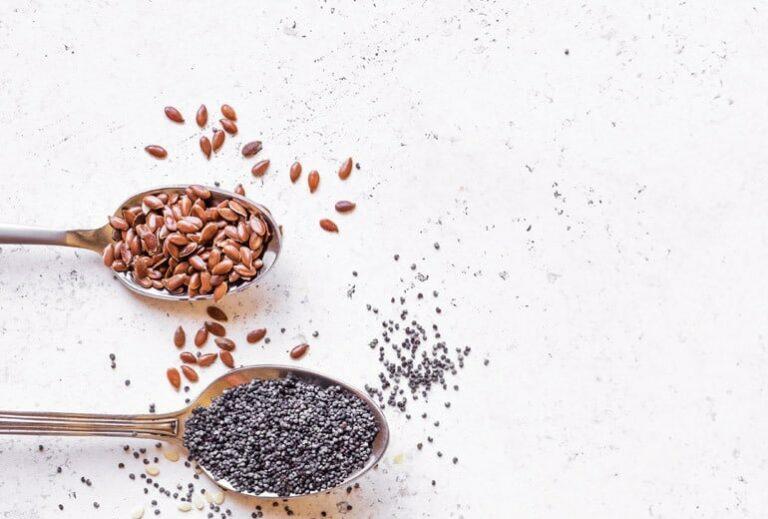
Chia seed and flax seed are two of my favorite superfoods! You often hear about these two little seeds in the same conversation, and for good reason––flax and chia offer a lot of the same big health benefits in their tiny packages––but there are times it’s better to use one versus the other.
In this post:
- How Chia Seeds And Flax Seeds Are Similar
- Advantages of Chia Seeds Over Flax Seeds
- Advantages of Flax Seeds Over Chia Seeds
- Chia Seeds vs. Flax Seeds: When to Use Each
- Chia Seeds and Flax Seeds in Green Smoothies
Here’s a brief guide on chia seed vs. flax seed to help you out at your next meal.
How Chia Seeds And Flax Seeds Are Similar
Chia and flax have a lot of the same nutritional benefits, including the following:
- They contain essential fatty acids (EFAs). Both seeds are good sources of omega-3 essential fatty acids, called “essential” because our bodies do not make EFAs and we must get them from our diet. Over 60% of the fat content in chia seeds is from omega-3s (alpha-linolenic acid or ALA), and 20% omega-6s1 (alpha-linoleic acid or LA), a naturally balanced ratio that keeps inflammation down (so important for heart health!).
As for flax seeds, they contain almost as much as chia seeds at 57%,2 contributing just as well to brain, nervous, immune, cardiovascular, and reproductive systems that require EFA for proper function. Because of the Standard American Diet’s heavy focus on omega-6 fatty acids, flax and chia can both help balance out your omega ratios with their high quantity of ALA.
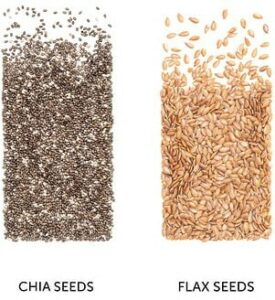
Chia and flax have a lot of the same nutritional benefits, but there are important differences, too.
- They help regulate blood sugar. Both seeds have soluble fiber and other components that can help with blood sugar stabilization, which many people who consume the Standard American Diet need, as high-carb processed foods are often stripped of the fiber needed to slow the release of carbohydrates into the bloodstream.
As carbohydrates convert to glucose, the fat and fiber in both chia and flax slow down their absorption, giving you steadier energy as well, instead of a spike and a crash. Flax has an added benefit of lignans, a plant compound that has been found to play a role in blood sugar stabilization.3
[Related: Green Smoothies For Diabetes: Mistakes, Tips, and Recipes]
- They can heal your digestive tract. Both chia seed and flaxseed contain mucilaginous fiber, meaning they absorb lots of water and become a bit slimy when wet. While it doesn’t sound very appetizing, that gel-like quality can be very healing to the digestive tract, increasing the growth of “good” bacteria by 25%.4
How does that happen? This fiber is considered prebiotic, so it feeds the good bacteria in the gut (probiotics) and allows them to proliferate, protecting you against bad bacteria. Fiber also helps promote regularity as well, cleansing your colon naturally.
- They’re beauty-boosting superfoods. The omega fatty acids and antioxidant content that both seeds contain are very nourishing for your hair and skin. While antioxidants help fight physical damage from free radicals, the omegas pitch in for beauty with healthier and shinier hair, more supple skin thanks to their ability to promote collagen production (the protein that gives our skin its resilience and glow), and helps relieve dry skin by moisturizing the body from within.
- They’re both gluten-free. Chia and flax make an excellent addition to a gluten-free diet and are especially helpful when it comes to gluten-free baking. Both are often used to provide a nutritional boost, but also as a binder to hold baked goods together where gluten might typically do the job. Ground flax is often blended with other gluten-free flours as well in recipes for muffins and breads.
- They can be sprouted. All of these great benefits are made even more amazing when the seeds are sprouted. We can sprout just about any nut, seed, or grain to eliminate its phytic acid, which essentially unlocks even more vitamin and mineral content. Because chia and flax contain that mucilaginous fiber, however, it’s really a mess to try at home, so the easiest way to eat sprouted flax and chia is in an already germinated, dried, and ground form. These ground powders make both seeds easy, versatile additions to the diet when you add it to a smoothie, your oatmeal or granola, or in any baking recipe.
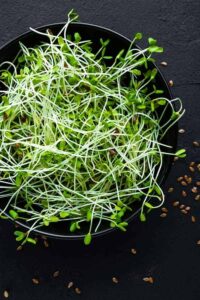
All the benefits of chia and flax increase dramatically when the seed is sprouted.
While both seeds are loaded with similar nutrients and benefits, there are some instances in which you’ll want to choose one over the other, and with both seeds, it’s always best to choose organic versions. Here’s an overview of whether flaxseed or chia seed is best for your particular needs.
Advantages of Chia Seeds Over Flax Seeds
- Chia seed is a complete protein. There are nine essential amino acids that we need to get from our diet, and the food we eat can contain all or some. Chia contains all nine, making it a complete protein. It’s one of those foods I love to point out when I get my least-favorite (and most-asked!) question ever, regarding myths about a plant-based diet: “But what about protein?”
Incomplete proteins aren’t something to really worry about if you’re getting a variety of protein-rich plant foods in your diet throughout the day. Chia simply gives you an extra protein boost from its complete amino acid profile, among its many other benefits.
- Chia can help you avoid cravings. Because of their ability to absorb 10 times their weight in water,5 chia seeds incorporated into your meals can help keep you fuller longer as it expands in your stomach.
Here’s one of my favorite health hacks: I like to have a tablespoonful of chia mixed into a big glass of water in between meals, to stave off hunger. Stir the seeds into the water, drink it down quickly, and 10 to 20 minutes later, your hunger is gone.
Because eating late at night is hard on your sleep cycles and your digestive system’s need for a rest, this is a great way to stop uncomfortable hunger pangs and sleep well.
- Chia seeds have more fiber. Both chia and flax are high in fiber, but chia wins in this department by having almost 10 grams per serving, according to the USDA Food Composition Database.6
We already talked about the way chia’s mucilage can be healing to the lining of the digestive tract, but its fiber improves digestion in another way by adding bulk to your stool, carrying out waste and toxins and helping you eliminate on a regular basis.
Stool that stays too long in the colon becomes rotten (which can also be the source of some not-so-pleasant gas); the gut can re-absorb those toxins, and a cascade of health issues can arise. Your body needs fiber to eliminate properly and regularly, and there are few foods as helpful as chia to keep things moving.
- Chia is high in calcium. Chia also reigns supreme in calcium content, containing nearly three times as much as flax. Anyone who is avoiding dairy will be happy to know they can get their bone-strengthening nutrients from this little seed (including magnesium and phosphorus as well), which support dental health and your nervous system, too.
- Chia supports blood health. Chia seeds are high in iron, a mineral that supports cellular respiration, meaning it helps carry oxygen through your red blood cells in order to produce energy.
If you’ve been feeling fatigued, weak, or unusually cold, it may be the result of low iron. While spinach is our usual first thought when it comes to increasing iron naturally, chia seeds actually contain almost three times as much as the leafy green.
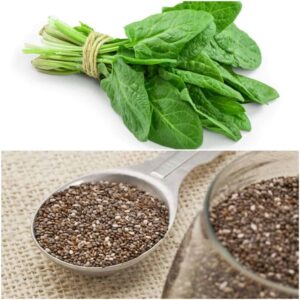
Chia seeds are a better plant-based source of iron than spinach.
Advantages of Flax Seeds Over Chia Seeds
- Flax contains lignans. One big perk flax has over chia is its lignan content, which is the highest among any plant source.
Lignans are anti-inflammatory plant compounds that are known to protect against cancer and tumor growth. Flaxseed is such a concentrated source of these helpful compounds that one serving has over 100 times the amount found in kale!7
Lignans are not found in flax oil, however, so make sure you’re consuming the whole, ground, or sprouted form of the seed if this is the benefit you’re looking for.
- Flax seeds have hormone-balancing effects. For women at the stage of their lives where hot flashes and mood swings are becoming the norm, the phytoestrogens that flax contains act as a regulator that can alleviate such strong side effects of menopause.11
Flax is one of the main foods recommended by naturopathic medical doctor Dr. Alan Christianson in our masterclass Hormone Health Revolution. Check out this video for what he has to say about why and how to use flax to help regulate hormones.
- Flax is higher in protein and healthy fat. Both seeds are great sources of protein and fat, but flax contains just a bit more in the same size serving––about 1 extra gram of protein and 3 extra grams of fat compared to chia. Protein content increases even more when the flax seeds are sprouted, the method of natural germination mentioned before that allows your body to access and absorb more of the seed’s nutrients.
[Related: 3 Fats That Hurt, 3 Fats That Heal]
- Flax can improve heart health. Although chia contains omega-3s as well, studies have found that flaxseed in particular lowers the risk of heart disease by reducing lipids within the bloodstream.8
The fiber content within flax helps the heart as well by keeping fat and cholesterol in the bowels instead of the rest of the body, allowing you to move them safely out of your digestive system.9
- Flax helps lower blood pressure. A 2013 study on hypertensive patients and the effects flaxseed had on them found that those who ate 1/4 cup of flax daily for six months lowered their diastolic blood pressure by seven points, on average.10 This improvement is often better than many medications can do for you, and while we’d never tell you to stop taking your medicine without talking to your doctor, it certainly doesn’t hurt to add flax into your diet.
- Flax promotes healthy aging. We tend to accept weaker bones and eyesight as we age, but that doesn’t have to be the case. Incorporating flax into your diet can help prolong your health in these areas, as flaxseed’s ratio of protein and fat content improves the quality of your bone density, as well as your optic nerves and retinas.12
Chia Seeds vs. Flax Seeds: When to Use Each
Aside from the health benefits of chia seeds and flax seeds, there are different occasions where you’ll want to use each one in baking and cooking as well. Here are just a few ways you can use them:
- As an egg replacer: Both seeds can be used as egg replacers in baking to help bind your baked goods together. Take 1 tbsp of either seed, mix with 3 tbsp of water, and let sit for a few minutes to let it gel before using to replace an egg.
Make sure you’re using ground flax instead of the whole seed when doing this. You can use ground chia too, but whole chia works just as well. I find that chia is a stronger binding agent, so it’s better for more dense baked goods, while a flax “egg” is better for lighter things like cakes.
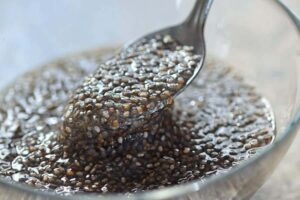
Chia and flax can be soaked to use as an egg replacer.
- In smoothies: I find that chia works better to thicken smoothies right away since it’s so readily able to absorb a lot of liquid. Ground flax can be used as a thickener as well, but it tends to work better if you’re making the smoothie ahead of time (like if you’re meal prepping for the next day); it gives your smoothie a pudding-like texture.
- Sprinkling on your meal: Either one adds an extra punch of nutrition, but as a matter of preference, I like ground flax for garnishing salads over chia, because chia’s binding ability can cause the salad dressing to congeal. On smoothie bowls, I still like ground flax because even though I think a sprinkling of chia is prettier, the seed can get stuck in my teeth!
- Breading: Ground flax is the winner here, substituting well for any time you would normally have used bread crumbs to coat veggies for baking or frying.
[Related: 15 Ways To Use Sprouted Flaxseed]
Chia Seeds and Flax Seeds in Green Smoothies
Both chia and flax seeds can be used to thicken smoothies, and they're even more nutritious when you use their organic sprouted versions. If you want to up your green smoothie game even more, here are a few combinations you can try depending on what you want out of your drink.
- For an iron boost in your diet: Add chia in with a spinach-based green smoothie.
- Maximize the potassium content: Add ground flax to a green smoothie that uses swiss chard as a base, with banana to sweeten.
- A dairy replacer for all your calcium needs: Add chia to a kale-based green smoothie.
- Up your Vitamin B1 (thiamin) levels: Blend up your favorite greens and berries with creamy avocado and ground flax seed.
- Make it anti-inflammatory: Add either chia or ground flax to a smoothie with turmeric and pineapple, which contains the enzyme bromelain that soothes inflammation.
- Balance your hormones: Blend ground flax with other hormone-balancing superfoods like maca powder and reishi in a chocolate smoothie––you can add a handful of spinach and it will still taste like a treat!
There are so many benefits to using chia and flax seeds in your daily diet, and they’re incredibly versatile as well.
Read next: What Are Anti-Nutrients, And Should You Avoid Them In Your Food?

Disclosure: This post may contain affiliate links that help support the GSG mission without costing you extra. I recommend only companies and products that I use myself.
Sources
- Ayerza, R. and Coates, W. “Some Quality Components of Four Chia (Salvia hispanica L.) Genotypes Grown under Tropical Coastal Desert Ecosystem Conditions.” Asian Journal of Plant Sciences. 2009 | Volume: 8 | Issue: 4 | Page No.: 301-307. DOI: 10.3923/ajps.2009.301.307
- Sargi, S.C. et al. “Antioxidant capacity and chemical composition in seeds rich in omega-3: chia, flax, and perilla.” Food Science and Technology.
- Prasad, Kailash. “Secoisolariciresinol diglucoside from flaxseed delays the development of type 2 diabetes in Zucker rat.” Journal of Laboratory and Clinical Medicine. Volume 138, Issue 1, July 2001, Pages 32-39. https://doi.org/10.1067/mlc.2001.115717
- Guevara-Arauza, Juan Carlos et al. “Prebiotic effect of mucilage and pectic-derived oligosaccharides from nopal (Opuntia ficus-indica).” Food Science and Biotechnology. August 2012, Volume 21, Issue 4, pp 997–1003. https://doi.org/10.1007/s10068-012-0130-1
- Vázquez-Ovando, Alfredo et al. “Physicochemical properties of a fibrous fraction from chia (Salvia hispanica L.)” LWT - Food Science and Technology. Volume 42, Issue 1, 2009, Pages 168-173. https://doi.org/10.1016/j.lwt.2008.05.012
- USDA Food Composition Database
- Higdon, Jane, et al. “Lignans.” Linus Pauling Institute: Micronutrient Information Center. 2010. https://lpi.oregonstate.edu/mic/dietary-factors/phytochemicals/lignans#food-sources
- Torkan, M et al. “Effect of flaxseed on blood lipid level in hyperlipidemic patients.” Reviews on Recent Clinical Trials. 2015;10(1):61-7. PMID: 25612882
- Kristensen, Mette et al. “Flaxseed dietary fibers lower cholesterol and increase fecal fat excretion, but magnitude of effect depend on food type.” Nutrition & Metabolism. 3 February 2012. https://doi.org/10.1186/1743-7075-9-8
- Rodriguez-Leyva, Delfin et al. “Potent Antihypertensive Action of Dietary Flaxseed in Hypertensive Patients.” Hypertension. 2013;62:1081-1089. https://doi.org/10.1161/HYPERTENSIONAHA.113.02094
- Phipps, W.R. et al. “Effect of flax seed ingestion on the menstrual cycle.” The Journal of Clinical Endocrinology & Metabolism. Volume 77, Issue 5, 1 November 1993, Pages 1215–1219. https://doi.org/10.1210/jcem.77.5.8077314
- Lenzi, Q et al. “Flaxseed used since pregnancy by the mother and after weaning by the offspring benefits the retina and optic nerve development in rats.” The Journal of Maternal-Fetal & Neonatal Medicine. 2018 Mar;31(5):625-632. doi: 10.1080/14767058.2017.1293028. Epub 2017 Feb 28.
Posted in: Natural Products, Preparedness, Reviews, Whole Food




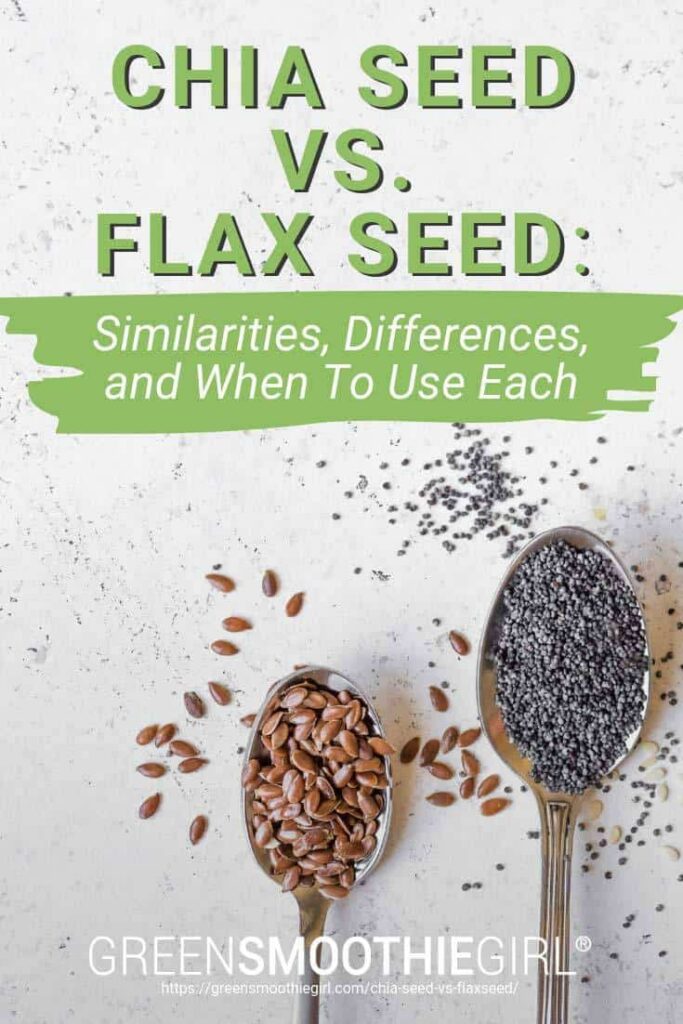













I recently wandlted to try the grounded Chia as my children don’t like the whole seed appearance and hence wouldn’t eat it.
Your article is very educational and highly informative.
Great inspiration also. Thank you!
Do you have any recipes?
Loved this article. New to plant based eating.
Thank you for your super-informative article. It’s very inspiring.
Just wondering if you use both chia seeds and Flax seeds together in a smoothie? Or you can’t mix them?
Can u use both chia and flax seed together
Yes, you absolutely can use chia and flax seed together in a smoothie. Our GreenSmoothieGirl Sprouted Tri-Omega has sprouted, ground flax seed, chia seed, and broccoli seed — an excellent plant-based way to get your omega-3s!
Check it out here: https://shop.greensmoothiegirl.com/products/greensmoothiegirl-triomega-superfood
—Lindsay, GreenSmoothieGirl
Love this article! So far chia seeds for me bc flaxseed can sometimes help or aggravate my PCOS. I’m feeling so much better and I’ve only been eating it for a few days. Its definitely keeping my blood sugar levels stable.
Thanks again
Thank you for this informative article about chia seeds and flax seed . I used always ground flax seed when preparing soups .
Do you have anything on green tea with chai seeds and or flex seeds
I like this post. It’s an eye-opener for me when it comes to getting protein based food. Once, I say thank you and God bless.
best tips to increase fat in a natural way
Hey, Does Flax seed help me hair growth also.
Flaxseed contains antioxidants and other essential nutrients. It's known for being a hair-friendly ingredient. Not only does it prevent hair loss, but also ensures healthy growth.